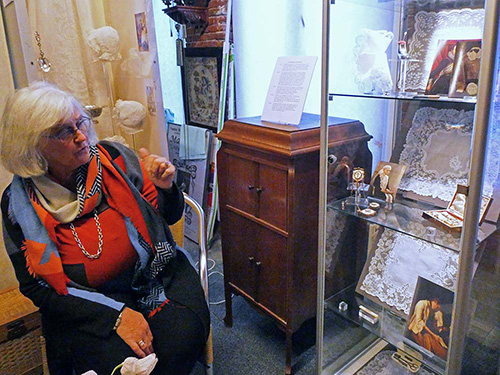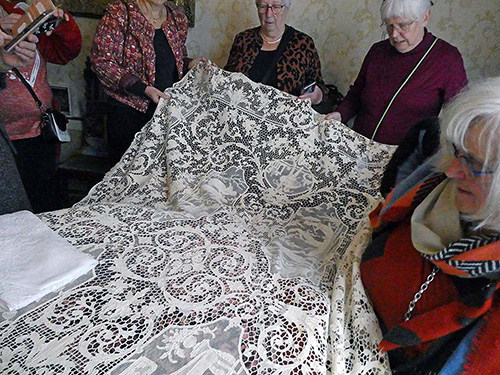
The Other Museum from Oltimer to Lace
Laceday of OIDFA, the Netherlands on the 21st of October 2023
This year the laceday for the Dutch members of OIDFAS in the ‘Other Museum from Oldtimer to Lace’ in Leeuwarden.
The true collectors, OIDFA member Mayken Geersing and her husband owned 2 collections, Mayken lacepillows and her husband classic cars. The museum is started about 20 years ago as a oldtimermuseum. When the space upstairs came up empty, it became a part of the museum to exhibit the collections lacepillows of Mayken. This exhibition was called ‘A Lace Journey through Europe’. These pillows were mostly obtained at the cities, which they visited during several OIDFA congresses. On the advice of museum experts a room was reserved for temporarliy exhibitions, such as the exhibitions ‘Textile Treasures’ and ‘The Linnenkast’, especially set up for us.
 Maykens husband had always new ideas, which he liked to realise. When in 2016 the museum was expanded, the Maria Louise room was set up.
Since 2019 after her husband passed away she runs the museum together with her youngest son.
Maykens husband had always new ideas, which he liked to realise. When in 2016 the museum was expanded, the Maria Louise room was set up.
Since 2019 after her husband passed away she runs the museum together with her youngest son.
During the years the collection is expanded thanks to donations of all kinds. Mayken noticed that children often do not know what to do with different things after the death of their parents. They then try to house them in a museum, but that is difficult.Established museums don’t want old radio’s, meccano building and embroidery samplers, made by granny. Mayken and her son used to accept everything, which was offered. Nowadays they are more critical about what they should accept or when to say no. Of course we didn’t come for the classic cars and radios, but for the lace collection.
We started in the Marie Louise room, This 18th century period room is dedicated to Marie Louise von Hessen-Kassel, in Friesland known as ‘Maaike Meu’, Auntie Maaike. She was married to Johan Willem Friso van Nassau en was the mother of Stadtholder Willem IV and as such the female ancestor of our royal family.
In a display case are various 18th century laces, including gold lace, as Marie Louise would have included in her trousseau.
 Mayken showed also laces of her private collection, such as e lace stole from the 18th century and a lappet coming from the same period. Also a piece of mahine-made Blonde was shown. About this piece a little discussion was started. Could it really be indentified as a Blonde, because there was no gimp and the runners in the cloth stitch motifs were not really flossy. In the beginning of machine-made lace it was nearly impossible for the machine to run a gimp through the lace and also flossy threads were difficult to handle. But it surely looked like a Blonde.
Mayken showed also laces of her private collection, such as e lace stole from the 18th century and a lappet coming from the same period. Also a piece of mahine-made Blonde was shown. About this piece a little discussion was started. Could it really be indentified as a Blonde, because there was no gimp and the runners in the cloth stitch motifs were not really flossy. In the beginning of machine-made lace it was nearly impossible for the machine to run a gimp through the lace and also flossy threads were difficult to handle. But it surely looked like a Blonde.
On the table there was a big tablecloth of needlelace. Probably it was made around 1910. The cloth contains several medallions of needle lace, which together tell a story.
 IIn the exposititionroom there was beside the ‘Textile Treasures’ the expositition ‘De Linnenkast’, consisting of the reconstructed laces of the pattern folders, De Linnenkast 1 to 5. The OIDFA working group ‘De Linnenkast’ was founded in 1992 to study old lace, which was found in museums and private collections as inserts on bedsheets, pillowcases and other linen. The oldest lace was found in the collection of ‘Borg Verhildersum’ in Leek (Groningen). This reticella bobbin lace comes from 1601 and is attached to probably the oldest bedsheet found in the Netherlands. During the congress in Groningen the 5th and last pattern folder was published. After that the group was disbanded. The reconstructed laces have been deposited at the museum.
IIn the exposititionroom there was beside the ‘Textile Treasures’ the expositition ‘De Linnenkast’, consisting of the reconstructed laces of the pattern folders, De Linnenkast 1 to 5. The OIDFA working group ‘De Linnenkast’ was founded in 1992 to study old lace, which was found in museums and private collections as inserts on bedsheets, pillowcases and other linen. The oldest lace was found in the collection of ‘Borg Verhildersum’ in Leek (Groningen). This reticella bobbin lace comes from 1601 and is attached to probably the oldest bedsheet found in the Netherlands. During the congress in Groningen the 5th and last pattern folder was published. After that the group was disbanded. The reconstructed laces have been deposited at the museum.
In the same room a showcase showed briefly the consequences of the intervention of Jean-Baptiste Colbert, politician in the government of Louis IV, in the French lace industry. The French lace industry flourished at the expense of the Italian one. Surprisingly enough, the Belgian lace industry was less affected. To find out more about this nice museum full of beautiful lace, visit their website: www.museumpakhuiskoophandel.nl Dit artikel werd eerder gepubliceerd in het OIDFA Bulletin nr. 1 van 2024.
Photos: Bettie Stijnman
The true collectors, OIDFA member Mayken Geersing and her husband owned 2 collections, Mayken lacepillows and her husband classic cars. The museum is started about 20 years ago as a oldtimermuseum. When the space upstairs came up empty, it became a part of the museum to exhibit the collections lacepillows of Mayken. This exhibition was called ‘A Lace Journey through Europe’. These pillows were mostly obtained at the cities, which they visited during several OIDFA congresses. On the advice of museum experts a room was reserved for temporarliy exhibitions, such as the exhibitions ‘Textile Treasures’ and ‘The Linnenkast’, especially set up for us.
 Maykens husband had always new ideas, which he liked to realise. When in 2016 the museum was expanded, the Maria Louise room was set up.
Since 2019 after her husband passed away she runs the museum together with her youngest son.
Maykens husband had always new ideas, which he liked to realise. When in 2016 the museum was expanded, the Maria Louise room was set up.
Since 2019 after her husband passed away she runs the museum together with her youngest son.During the years the collection is expanded thanks to donations of all kinds. Mayken noticed that children often do not know what to do with different things after the death of their parents. They then try to house them in a museum, but that is difficult.Established museums don’t want old radio’s, meccano building and embroidery samplers, made by granny. Mayken and her son used to accept everything, which was offered. Nowadays they are more critical about what they should accept or when to say no. Of course we didn’t come for the classic cars and radios, but for the lace collection.
We started in the Marie Louise room, This 18th century period room is dedicated to Marie Louise von Hessen-Kassel, in Friesland known as ‘Maaike Meu’, Auntie Maaike. She was married to Johan Willem Friso van Nassau en was the mother of Stadtholder Willem IV and as such the female ancestor of our royal family.
In a display case are various 18th century laces, including gold lace, as Marie Louise would have included in her trousseau.
 Mayken showed also laces of her private collection, such as e lace stole from the 18th century and a lappet coming from the same period. Also a piece of mahine-made Blonde was shown. About this piece a little discussion was started. Could it really be indentified as a Blonde, because there was no gimp and the runners in the cloth stitch motifs were not really flossy. In the beginning of machine-made lace it was nearly impossible for the machine to run a gimp through the lace and also flossy threads were difficult to handle. But it surely looked like a Blonde.
Mayken showed also laces of her private collection, such as e lace stole from the 18th century and a lappet coming from the same period. Also a piece of mahine-made Blonde was shown. About this piece a little discussion was started. Could it really be indentified as a Blonde, because there was no gimp and the runners in the cloth stitch motifs were not really flossy. In the beginning of machine-made lace it was nearly impossible for the machine to run a gimp through the lace and also flossy threads were difficult to handle. But it surely looked like a Blonde.On the table there was a big tablecloth of needlelace. Probably it was made around 1910. The cloth contains several medallions of needle lace, which together tell a story.
 IIn the exposititionroom there was beside the ‘Textile Treasures’ the expositition ‘De Linnenkast’, consisting of the reconstructed laces of the pattern folders, De Linnenkast 1 to 5. The OIDFA working group ‘De Linnenkast’ was founded in 1992 to study old lace, which was found in museums and private collections as inserts on bedsheets, pillowcases and other linen. The oldest lace was found in the collection of ‘Borg Verhildersum’ in Leek (Groningen). This reticella bobbin lace comes from 1601 and is attached to probably the oldest bedsheet found in the Netherlands. During the congress in Groningen the 5th and last pattern folder was published. After that the group was disbanded. The reconstructed laces have been deposited at the museum.
IIn the exposititionroom there was beside the ‘Textile Treasures’ the expositition ‘De Linnenkast’, consisting of the reconstructed laces of the pattern folders, De Linnenkast 1 to 5. The OIDFA working group ‘De Linnenkast’ was founded in 1992 to study old lace, which was found in museums and private collections as inserts on bedsheets, pillowcases and other linen. The oldest lace was found in the collection of ‘Borg Verhildersum’ in Leek (Groningen). This reticella bobbin lace comes from 1601 and is attached to probably the oldest bedsheet found in the Netherlands. During the congress in Groningen the 5th and last pattern folder was published. After that the group was disbanded. The reconstructed laces have been deposited at the museum.In the same room a showcase showed briefly the consequences of the intervention of Jean-Baptiste Colbert, politician in the government of Louis IV, in the French lace industry. The French lace industry flourished at the expense of the Italian one. Surprisingly enough, the Belgian lace industry was less affected. To find out more about this nice museum full of beautiful lace, visit their website: www.museumpakhuiskoophandel.nl Dit artikel werd eerder gepubliceerd in het OIDFA Bulletin nr. 1 van 2024.
Photos: Bettie Stijnman